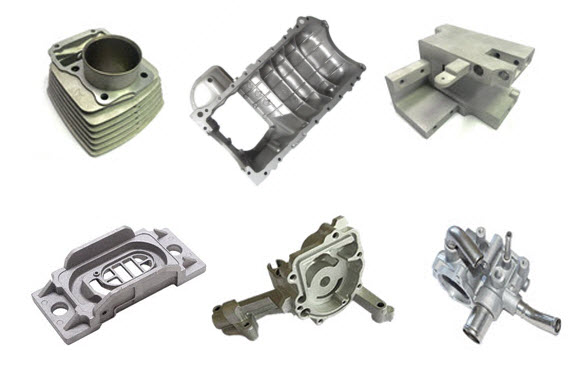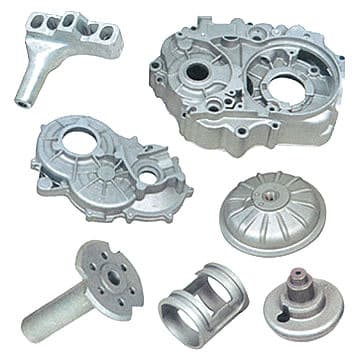The future of Aluminum Castings in sustainability
The Duty of Aluminum Casting in Progressing Sustainable Manufacturing Practices
Aluminum casting serves as a necessary component in promoting lasting production practices. Its capability to generate top quality components with a decreased ecological impact is exceptional. The process not just supports energy effectiveness but likewise significantly improves recyclability. Nonetheless, obstacles stay in completely realizing its potential. Discovering the technologies in aluminum casting innovation could reveal solutions that align making with sustainability goals. The effects of these developments are worth thinking about.
Understanding Aluminum Casting and Its Process
Aluminum casting has actually been a basic process in making for decades, its relevance proceeds to grow in different markets due to its adaptability and efficiency. This process includes pouring molten aluminum right into mold and mildews to produce intricate shapes and elements, making it suitable for producing lightweight yet long lasting products. The aluminum casting process can be categorized into numerous approaches, including sand casting, pass away casting, and financial investment casting, each offering unique benefits fit to specific applications.
Throughout the casting procedure, aluminum is heated to its melting point, permitting it to stream conveniently into molds that specify the last form. When cooled, the aluminum solidifies, leading to a strong and precise element. The capacity to produce complex geometries with marginal waste emphasizes aluminum casting's role in modern-day manufacturing - Aluminum Castings. As industries seek ingenious options, recognizing this process becomes necessary for enhancing manufacturing and fulfilling the needs of an evolving market
Ecological Advantages of Aluminum Casting
As sectors progressively prioritize sustainability, the ecological advantages of aluminum casting become much more noticable. One significant benefit is the material's recyclability; aluminum can be reused continuously without deteriorating its quality. This decreases the amount of waste sent out to garbage dumps and decreases the need for virgin products, saving natural deposits. Additionally, the aluminum casting process produces fewer greenhouse gas discharges compared to other metal casting methods, adding to reduced total ecological impact.
One more advantage lies in the light-weight nature of aluminum, which results in fuel performance in transportation applications. By making use of aluminum elements, makers can lower lorry weight, causing lowered gas consumption and exhausts throughout procedure. Additionally, developments in aluminum casting modern technologies have actually brought about a decrease in harmful waste manufacturing, improving overall ecological safety. Jointly, these variables position aluminum casting as a vital gamer in advertising sustainable production techniques and meeting ecological goals throughout numerous industries.
Power Effectiveness in Aluminum Production
Power effectiveness plays a crucial role in aluminum production, significantly influencing overall sustainability. By adopting cutting-edge casting strategies and integrating sustainable power sources, suppliers can achieve decreased power consumption throughout the manufacturing procedure. This change not just lowers functional prices but also contributes to an extra eco-friendly sector.

Reduced Power Consumption
While the aluminum manufacturing market has actually typically been energy-intensive, recent innovations have actually considerably enhanced power effectiveness throughout the manufacturing procedure. Innovations in smelting technology and the fostering of high-efficiency heating systems have substantially reduced power intake. These enhancements enable producers to make use of much less energy per system of output, lessening greenhouse gas discharges and lowering operational costs. Additionally, the integration of renewable resource sources right into production facilities additionally adds to lowered reliance on nonrenewable fuel sources, advertising sustainability. Carrying out sophisticated insulation products and enhancing warmth recuperation systems likewise plays a vital duty in optimizing energy efficiency. As an outcome, the aluminum industry is making considerable strides toward minimizing its general ecological impact while meeting the raising demand for lasting practices in production.
Cutting-edge Casting Methods
Innovative casting methods are changing the aluminum manufacturing landscape, enhancing both performance and sustainability. Advanced methods such as die casting and financial investment casting decrease product waste and improve dimensional accuracy, resulting in lowered power consumption throughout the production process. Methods like rapid solidification and semi-solid processing allow for far better control over metallurgical residential or commercial properties, leading to lightweight and high-strength elements. In addition, the application of computer simulations and automation in casting procedures optimizes cycle times and lowers problem rates. These technologies not just improve production however also add to the round economic situation by enabling the recycling of aluminum scrap into top notch items. Because of this, the aluminum sector is poised to satisfy growing needs while adhering to lasting production methods.
Renewable Power Combination
A significant shift towards renewable resource integration is improving power effectiveness in aluminum production. This adjustment entails using solar, wind, and hydropower sources to minimize reliance on nonrenewable fuel sources, significantly reducing carbon discharges. Facilities are progressively adopting energy-efficient innovations, such as innovative electrolytic processes, which maximize power usage find this throughout aluminum production. By using eco-friendly energy, manufacturers not just reduce operational expenses but likewise improve their sustainability profiles. Additionally, wise grid technologies assist in the smooth combination of eco-friendly resources, permitting more steady power products. As the industry embraces these innovations, the aluminum sector is positioned to lead in lasting methods, demonstrating a commitment to environmental stewardship while meeting boosting global demand for light-weight, high-performance products.
The Recyclability of Aluminum and Its Impact
Aluminum's recyclability offers considerable advantages in sustainable production, permitting for boundless recycling without loss of quality. This property not only minimizes waste however also enhances energy effectiveness throughout the recycling procedure. Because of this, the effect on both the setting and manufacturing costs is extensive, making aluminum a popular material in eco-conscious industries.
Infinite Recycling Potential
Although lots of products lose quality through recycling processes, aluminum stands apart due to its boundless recyclability, which substantially adds to helpful resources lasting production practices. This one-of-a-kind characteristic allows aluminum to be reused repeatedly without degrading its buildings, making it a beneficial source in various industries. The lifecycle of aluminum begins once more with each reusing initiative, saving resources and reducing waste. This not just lessens the environmental effect but additionally fosters a circular economic climate where aluminum can be reused plenty of times. The high need for recycled aluminum even more emphasizes its significance in sustainable manufacturing, as it improves resource performance and promotes an environmentally friendly strategy to manufacturing. Ultimately, the limitless reusing potential of aluminum plays a substantial function beforehand sustainable practices throughout markets.

Power Effectiveness Benefits
Substantial energy cost savings are recognized through the recycling of aluminum, highlighting its function in sustainable manufacturing. Recycling aluminum requires only 5% of the energy required to generate new aluminum from basic materials. This considerable reduction in energy intake equates into lower greenhouse gas exhausts, adding to environmental sustainability. The power efficiency of aluminum recycling not only saves resources yet additionally lowers operational costs for manufacturers, making it a financially feasible alternative. In addition, the procedure of reusing aluminum can be incorporated right into existing assembly line without substantial disturbance, improving total performance. As markets progressively prioritize sustainability, the recyclability of aluminum settings it as a principal beforehand energy-efficient manufacturing techniques, promoting a round economic situation and advertising liable resource administration.
Challenges Encountering Aluminum Casting in Sustainable Practices
While the aluminum casting market has actually made strides in the direction of sustainable techniques, a number of difficulties continue to be that hinder its progress. One considerable problem is the high energy consumption connected with standard casting techniques, which commonly depends on nonrenewable fuel sources. This dependancy not only enhances operational expenses yet likewise contributes to greenhouse gas discharges. Furthermore, the reusing procedure for aluminum can be inefficient, bring about worldly loss and boosted waste. An additional difficulty is the minimal accessibility of sustainable raw products, as sourcing recycled aluminum can be difficult and pricey. In addition, regulative pressures and differing ecological requirements across areas complicate conformity initiatives, making it testing for companies to adopt uniform sustainable methods. Ultimately, labor force training remains insufficient, with many workers doing not have the required abilities to implement innovative, green techniques in casting processes. Resolving these obstacles is important for the aluminum casting market to completely recognize its capacity in lasting production.
Advancements in Aluminum Casting Innovation
To conquer the obstacles dealt with in sustainable methods, the aluminum casting industry is seeing a wave of technologies targeted at enhancing performance and lowering environmental effect. Advanced casting methods, such as 3D printing and die casting, are being taken on to minimize product waste and enhance precision. These technologies enable suppliers to generate complex geometries with less aluminum, thus conserving sources.
Furthermore, the combination of reusing techniques, including closed-loop systems, assists in making use of scrap aluminum, greatly minimizing power intake compared to primary aluminum manufacturing. Boosted mold and mildew styles and finishings are additionally contributing to sustainability by improving thermal home performance and minimizing emissions throughout the casting procedure.
Automation and wise production technologies are being executed to optimize production processes, resulting in decreased cycle times and energy usage. Jointly, these technologies stand for a considerable shift towards even more sustainable practices within the aluminum casting field, lining up with broader ecological objectives.
Future Potential Customers for Sustainable Manufacturing With Aluminum Casting
As the need for sustainable manufacturing techniques increases, the aluminum casting industry is poised to play a critical function in forming a greener future. The field is significantly adopting recycling procedures that significantly minimize waste and energy usage, straightening with global sustainability goals. Advancements such as low-energy casting methods and the use of recycled aluminum not just decrease carbon footprints however additionally boost the overall effectiveness of production.

As industries look for to abide with stricter ecological guidelines, the aluminum casting industry stands ready to supply lasting remedies, positioning itself as a principal in the change in the direction of environmentally friendly manufacturing techniques in numerous industries, including auto and aerospace.
Often Asked Concerns
How Does Aluminum Casting Contrast to Other Metal Casting Approaches?
Aluminum casting typically supplies benefits such as lower melting points and premium recyclability compared to various other steel casting approaches. Its lightweight nature and excellent rust resistance better enhance its charm in different production applications.
What Industries Benefit Many From Aluminum Casting?
Various markets, consisting of vehicle, aerospace, and consumer goods, considerably benefit from aluminum casting - Aluminum Castings. This approach's lightweight, corrosion-resistant residential properties improve item performance while enabling detailed styles, making it an eye-catching choice for producers seeking performance and innovation
Can Aluminum Casting Be Utilized for Facility Layouts?
Aluminum casting can successfully accommodate complex designs because of its flexibility and capacity to develop complex forms. This process enables manufacturers to create lightweight, long lasting components suitable for numerous applications across different markets, enhancing technology and efficiency.
What Is the Life Expectancy of Aluminum Cast Products?
The lifespan of aluminum actors items usually varies from a number of decades to over a century, depending upon variables such as environmental problems, upkeep, and the certain application. Longevity makes them ideal for various long-lasting usages.
Just How Does Aluminum Casting Influence Job Creation in Manufacturing?
Aluminum casting considerably adds to work creation in production by promoting experienced labor possibilities, sustaining regional economic situations, and encouraging technological improvements. This procedure not just enhances production performance but likewise promotes workforce advancement and training initiatives.